The Intrinsic Value of Jade: An In-Depth Analysis
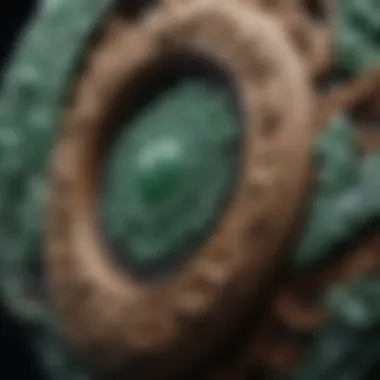
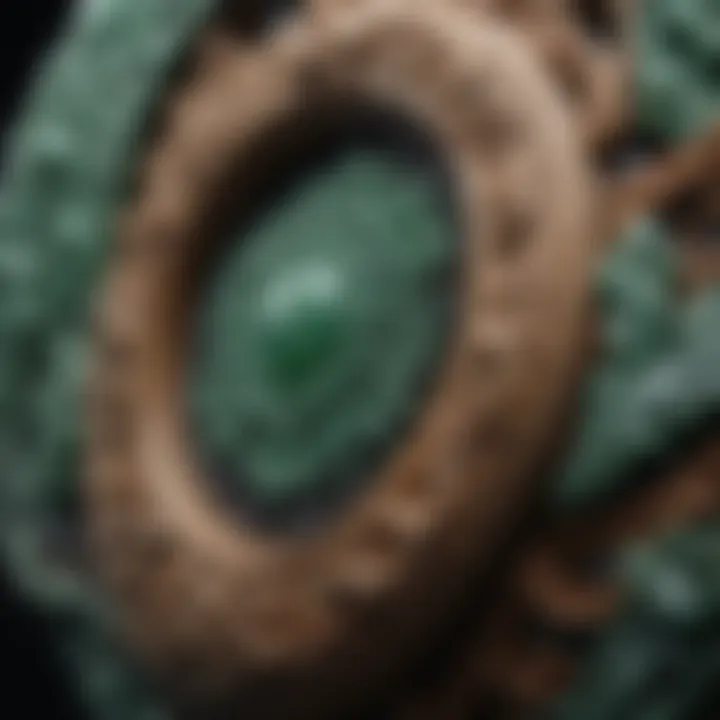
Intro
Jade has captivated human hearts and minds across ages and cultures. This beautiful gemstone is more than just a stunning accessory; it carries deep meanings and histories intertwined with various civilizations. Delving into the intrinsic value of jade provides not only insights into its market worth but also highlights its profound cultural and historical significance.
Gemstone Overview
Definition and Characteristics
Jade, primarily found in two notable forms—jadeite and nephrite—offers a stunning palette of colors, ranging from vivid greens to soft lavenders. The term jade encompasses these varieties which are different in chemical makeup and origins. Notably, jadeite is rarer and more valuable than nephrite. Jade, with its smooth texture and lustrous appearance, has made its mark in various forms, whether crafted into ornaments or utilized in carvings.
Classification of Gemstones
Gemstones are categorized based on a variety of factors, including their physical properties, origins, and value. Jade fits snugly into several classifications:
- Precious vs. Semi-Precious: Traditionally, jade has been considered a precious stone, a reputation it earned over centuries. However, in modern contexts, it is often regarded as semi-precious, particularly nephrite.
- Natural vs. Synthetic: Most jade in the market is natural, but synthetic versions exist. They can mimic the color and clarity of genuine jade, which is essential for collectors and connoisseurs to recognize.
- Gemological Attributes: The quality of jade can be assessed through its hue, transparency, texture, and craftsmanship involved in its production. A stone that exhibits vivid color, high translucence, and fine texture can command a substantial price tag.
Historical Significance
Ancient Uses and Cultural Importance
Historically, jade has held a place of reverence within numerous cultures. In Ancient China, it was deemed the ultimate symbol of purity, nobility, and immortality. Rulers adorned themselves with jade jewelry, believing it safeguarded them against misfortune. Similarly, Mesoamerican civilizations, such as the Mayans and Aztecs, cherished jade for its spiritual significance, utilizing it in burial practices and as currency.
"Jade is not merely a stone; it is a bridge to our ancestors, linking past with present across continents and cultures."
Myths and Legends Surrounding Gemstones
Jade is shrouded in an array of myths and legends that elevate its mystique. In Chinese folklore, it is believed that jade can ward off evil spirits and promote peace. Meanwhile, in Maori tradition from New Zealand, jade, known as pounamu, represents strength and is considered a taonga, or treasure, embodying the essence of the land. Such stories reveal how jade transcends its physical properties, becoming a bearer of cultural identity and meaning.
Preface to Jade
Jade, a gemstone that carries immense cultural, historical, and economic significance, holds a unique position in the world of precious stones. It’s not just about its beauty but rather about the narratives woven into its very essence. As we embark on this journey through jade, we’ll explore how it has transcended time and geography, impacting civilizations from Asia to the Americas.
Understanding Jade
Understanding jade means recognizing its dual composition—jadeite and nephrite. Many might think of these as simple gem types, but they each come with a rich story. Jade has served as currency, a symbol of virtue, and even protection against evil. If stones could talk, jade would narrate tales of royalty, spirituality, and profound artistry. In today’s market, jade retains its allure, promising both collectors and investors excitement as they navigate this colorful world.
The Different Types of Jade
Jade isn’t just one stone; it encompasses two main types, each with distinct characteristics and histories that add to their intrinsic value.
Jadeite
Jadeite is often considered the more precious of the two jade varieties, known for its vibrant hues and rarity. Its vivid greens, often interspersed with shades of lavender and white, can make one's eyes pop. Collectors particularly value jadeite for its unique colors, which range from intense emerald to more subtle pastels. This gemstone isn't just a pretty face; its toughness and resilience lend credibility to its use in intricate carvings and delicate jewelry. Furthermore, jadeite's association with high status in various cultures elevates its appeal among gemstone enthusiasts.
- Key Characteristic: The intense and varied color spectrum of jadeite is unmatched.
- Unique Feature: Its rarity compared to nephrite means jadeite pieces often command higher prices.
- Advantages: Jadeite's hues allow for a broad design influence in jewelry and art, attracting many designers.
However, the downside lies in the high cost of genuine jadeite, which might deter some collectors.
Nephrite
On the other hand, nephrite has a sturdy reputation built over centuries. Best known for its earthy tones, ranging from creamy white to deep olive green, nephrite has often graced the hands of artisans across many cultures. Its durability makes it more accessible for those wishing to work with jade in everyday items. Nephrite's toughness is why it shines in both utilitarian and artistic endeavors.
- Key Characteristic: Its softer, more muted refine tones, often paired with a silky finish.
- Unique Feature: More abundant than jadeite, making it more approachable for everyday collectors.
- Advantages: The affordability of nephrite allows for greater experimentation in jewelry design without fear of economic loss.
However, nephrite’s commonality can lead to it being overshadowed by the more glamorous jadeite in the eyes of collectors.
In examining the types of jade, one realizes that both varieties offer distinct but equally profound intrinsic values that extend far beyond their visual appeal.
By diving into the depths of jadeite and nephrite, we not only understand their individual importance but also gain insights into their roles in the larger context of jade’s esteemed legacy. This exploration sets the stage for further discussions about jade's historical context, cultural significance, and its physical properties—delving deep into what makes jade a staple in both the gemological world and collectible markets.
Historical Context of Jade
The historical context of jade speaks volumes about its role in shaping human civilization. This gemstone has been more than just a pretty rock; it embodies the beliefs, values, and customs of various cultures throughout history. Diving into the intricacies of jade's past, one can appreciate its multifaceted significance in art, trade, and ritual practices among ancient civilizations. Understanding this context not only enriches our knowledge of jade but also sheds light on how it retains its allure in today’s modern gem market.
Ancient Civilizations and Jade
China
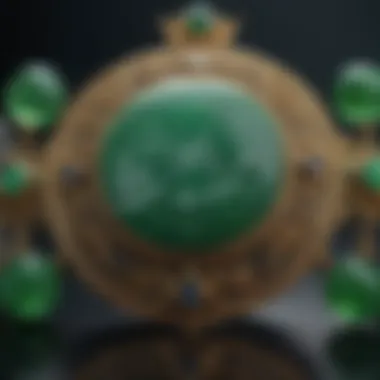
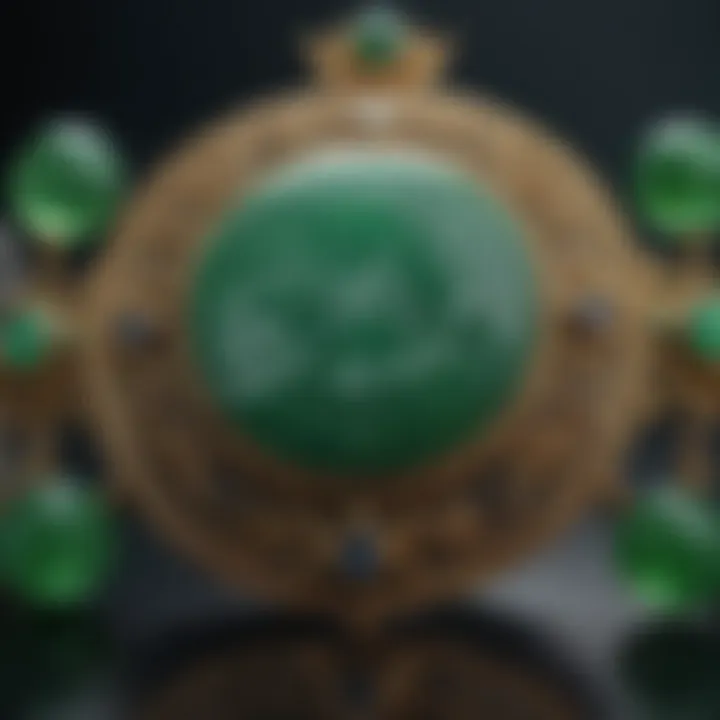
China stands as a prominent player in the jade narrative, primarily due to its deep-rooted cultural significance. Traditionally, jade has been revered as a medium that carries protective qualities and symbolizes purity and moral integrity. For the Chinese, jadeite and nephrite are not just stones; they represent ideals and values that have persisted for thousands of years.
A key characteristic of jade in Chinese culture is the concept of auspiciousness. It is often used in amulets or carved into figurines, each piece serving as a talisman against misfortune. The green hue of jadeite, in particular, is noted for its attractiveness and symbolism of vitality. Significant historical events, such as the construction of intricate jade burial suits during the Han Dynasty, showcase the importance the stone held.
One unique feature of Chinese jade craftsmanship is the meticulous carving techniques employed by artisans, which have evolved over centuries into a highly regarded art form. This not only preserves the cultural identity but also enhances the gemstone's market desirability, making it a timeless collectible in and out of Mainland China.
On the flip side, the increasing geopolitical tensions affecting jade exports could pose challenges, inviting scrutiny on sourcing while questioning authenticity in the marketplace.
Mesoamerica
On another side of the world lies Mesoamerica, where jade served an equally profound purpose, especially among ancient cultures like the Olmec and Maya. The significance of jade here is denoted by its use in ritualistic contexts and as a status symbol, often fashioned into ceremonial items and jewelry that adorned the elite.
What stands out is the vibrant use of varying colors of jade, particularly the deep greens and bright yellows, showcasing not just a preference for color but an appreciation for craftsmanship. Like in China, these pieces were often embedded in burial rites, placed alongside the deceased to ensure safe passage to the afterlife.
A unique advantage Mesoamerican jade offers is its association with life; the stone is frequently linked to water and fertility, reflecting the intrinsic beliefs of nurture and growth. This connection made it a beneficial choice in various cultural ceremonies.
However, one must be aware of the converse dynamic—the trade of jade has been historically intertwined with issues of exploitation and cultural appropriation, leaving a murky legacy that demands thoughtful consideration today.
Jade in Art and Artifacts
Jade's allure is not only evident in its material composition but also in its translation into art and artifacts that tell stories of human ingenuity and tradition. The range of jade artifacts—from ornaments to tools—exemplifies a cultural tapestry that illustrates the societal values and artistic expressions across various eras. This section will delve deeper into notable artifacts and their implications, showcasing how jade transcends mere elegance to encapsulate history, artistry, and identity.
Cultural Significance of Jade
Jade holds a prominent place in various cultures, functioning as a symbol of beauty, virtue, and status. Diving into its cultural significance reveals a rich tapestry of meanings that evolve over time and across different societies. Studying jade's role in various cultures helps us understand human expression and the connections we forge with nature and the world around us. The gemstone serves not only as a decorative piece but also as a vessel of cultural identity, protest, and unity.
Symbolism in Different Cultures
Chinese Culture
Jade in Chinese culture is steeped in an emblematic significance. For centuries, it has been perceived as the ultimate gemstone, embodying qualities like purity, wisdom, and virtue. The sentiment can be traced back to ancient Chinese writings, where jade was often associated with moral integrity and high moral character. Traditionally, jade is believed to possess protective qualities, hence its prevalence in talismans and ceremonial items. This emphasis on jade reflects a profound respect for natural elements, as well as an acknowledgment of their spiritual impact.
One of the distinguishing features of jade in this context is its color, specifically the deep green hue that symbolizes prosperity and good fortune. The ornamental use of jade can be seen in ceremonial objects such as the jade burial suit worn by royals, highlighting its importance for wealthy families and rulers. Such aspects make jade not just a mere gemstone but a pivotal part of cultural legacy, proudly showcased in familial heritage.
Moreover, the intricate artistry found in jade carvings further underscores its cultural weight. Each carving holds stories and meanings — from dragons symbolizing strength to phoenixes representing rebirth. This combined artistic element makes jade deeply captivating, making it an invaluable subject in the study of cultural symbolism.
āori Culture
In Māori culture, jade, known as pounamu, plays a vital role as a spiritually significant stone. It is considered a taonga, or treasure, representing both kinship and cultural heritage. Pounamu is more than just a physical object; it carries the mana, or spiritual authority, of the ancestors. This connection emphasizes the concept of whakapapa, or genealogy, where every piece of pounamu is traced back to its origin, linking the present with the past.
A key characteristic of pounamu is its wide variety, coming in multiple shades, which hold different meanings across Māori tribes. For example, the green variant symbolizes life and fertility, while the darker tones might represent strength and valor. Each piece is unique, distinguished not just by its beauty but also by the stories it tells about the tribe’s history, ensuring its significance is multifaceted.
Nonetheless, the integration of jade into Māori culture carries certain challenges. The impact of commercial demand can lead to issues surrounding the appropriation and exploitation of this cultural symbol. As lifestyles evolve, the balance between preserving tradition and adapting to modernity becomes crucial when discussing pounamu’s significance.
Jade in Religion and Spirituality
The spiritual significance of jade transcends cultural boundaries. Often associated with immortality and the afterlife, jade serves as a link between the earthly realm and the divine. Many traditions across the globe regard jade as a channeling stone, invoking protective energies for the wearers.
In various religious practices, jade is integrated into rituals and ceremonies. For instance, in Buddhism, it is common to find jade statues reflecting characteristics like serenity and tranquility, which serve as focal points for meditation and reflection. This aspect of jade offers insight into humanity's eternal quest for meaning and eternity.
Physical Properties of Jade
Jade, with its rich historical significance, finds part of its allure in its unique physical properties. Understanding these properties is crucial as they play a pivotal role in determining the gemstone's value, desirability, and application in various forms. The primary types of jade—jadeite and nephrite—exhibit distinct characteristics that influence not only their aesthetic appeal but also their worth in both ancient traditions and modern markets. Let’s delve into a more detailed analysis of these properties to understand their relevance.
Comparative Analysis of Jadeite and Nephrite
Color
Color is one of the most striking features of jade. Jadeite is often celebrated for its vivid hues, ranging from a pristine white to deep greens and even lavender. Nephrite, on the other hand, tends to display a more subdued palette, often including darker greens and browns. The key characteristic for jadeite is its ability to exhibit brighter, more dynamic colors, which makes it particularly attractive to collectors.
A unique feature of jadeite's color is how it can reflect light differently depending on the angle. This optical play can enhance the perceived depth of color, contributing to its sought-after status. The vibrancy of jadeite can also command higher prices on the market, as buyers tend to favor vivid shades, while nephrite, despite its beauty, might not fetch the same premium due to its more muted tones.
In a nutshell, the specific aspect of color not only adorns jade but also serves as a criterion for valuation, guiding collectors and investors alike in their choices.
Transparency
Transparency in jade is another element that significantly impacts its perception and pricing. Jadeite can vary from fully translucent to opaque, while nephrite usually leans towards a more opaque property. A popular choice particularly among enthusiasts is that translucent jadeite tends to literally light up when the light hits it right, creating a stunning visual impact.

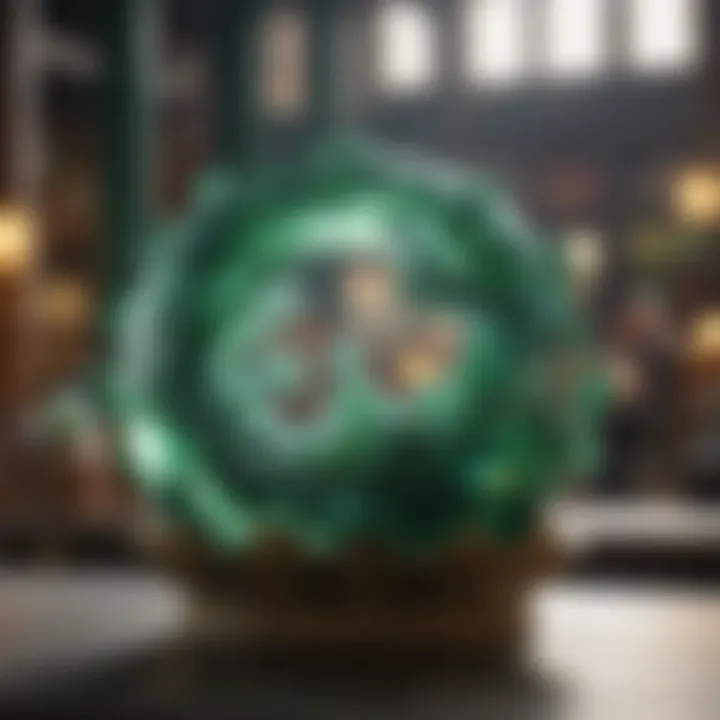
What’s unique about transparency is that even full opaque jade can be valued higher if it has a rich color and intricate carving details. Essentially, while nephrile may not shine as brightly in terms of transparency, its opacity could still signify strength and durability. Hence, transparency is not merely about aesthetics; it also informs potential buyers about the structural integrity and craftsmanship depth of the piece in question.
Texture
The texture of jade can greatly influence its appeal, providing tangible sensations that enhance the overall experience of the gemstone. Jadeite usually has a smoother, more polished finish, which feels luxurious to the touch. This contrasts with nephrite, which can exhibit a more fibrous texture.
A key characteristic of jade’s texture is its capability to carry intricate designs when carved, allowing artisans to display their skills effectively. For example, the fine finish of jadeite makes it the beneficial go-to for detailed carvings, making it popular for delicate jewelry pieces. The fibrous nature of nephrite, however, can lend it a rugged charm, often resonating with consumers looking for authenticity over refinement.
Assessing Quality and Rarity
When assessing jade's quality and rarity, several factors come into play. The origin of the jade, its overall appearance, and any unique inclusions must be weighed carefully. Color richness, texture quality, and degree of transparency are vital indicators as well. Jade's rarity often enhances its desirability. For instance, a jadeite from Myanmar that presents striking color and transparency can be rather enthusiastically priced due to its limited availability.
End
The diverse physical properties of jade—color, transparency, and texture—not only distinguish between jadeite and nephrite but also create narratives that connect buyers to their pieces. Each aspect serves as a lens through which collectors can draw personal meaning or aesthetic pleasure, nourishing the ancient bond humanity has crafted with this gemstone.
Market Dynamics of Jade
Understanding the market dynamics of jade goes beyond mere numbers and graphs. It's about grasping the intricate dance of supply and demand, where cultural significance meets economic factors. Jade, revered for centuries, plays a multifaceted role in various societies, intermingling history with modern trends. Let’s dive into the nitty-gritty of what drives jade's market today, looking closely at different elements that shape its value and relevance.
Global Demand and Supply Trends
The jade market is a fascinating blend of tradition and contemporary trends. Demand characteristics can vary significantly across different regions. In countries like China, jade is not merely a gemstone; it’s a symbol of status and heritage. Here, the jade market has seen a resurgence, stimulating hefty demand that often outstrips supply. This phenomenon is not just local; globally shared appreciation for jade has elevated its desirability.
On the supply side, the story is quite complex. Mines, mostly located in Myanmar, host the bulk of the world’s jadeite supply. However, factors such as political issues, environmental regulations, and even mining practices can create bottlenecks. Restricted access to quality jade can lead to increased prices, causing investors and affluent collectors to rethink their purchasing behaviors.
Moreover, the emergence of online platforms has altered traditional distribution channels, allowing smaller suppliers to offer jade to a broader audience while disrupting long-standing industry norms. The world now has a finger on the pulse of this vibrant market, making it essential for anyone interested in jade to keep a close eye on these trends.
"Jade is a stone that embodies both beauty and significant cultural value, making it a favorite among collectors and investors alike."
Investment Potential of Jade
When discussing jade as an investment, it’s vital to acknowledge both risks and rewards. The crystallization of jade's value as an asset class has gained traction, attracting not only gemstone enthusiasts but also savvy investors. So, why is jade considered an appealing investment?
- Rarity of Quality – Premium quality jadeite, particularly the imperial green, fetches astounding prices. As quality jade becomes scarcer, its investment value continues to rise.
- Cultural Relevance – The sentimental and cultural significance attached to jade amplifies its allure. Whether it’s traditional Chinese wedding gifts or Māori tribal adornments, the depth of meaning inherently tied to jade can bolster its market stability.
- Diversification – For investors looking to diversify their portfolio, jade presents a unique alternative to conventional assets, bridging the gap between art and geology. In an ever-changing market, this can be a strategic play.
- Market Growth – With increasing global wealth, particularly in Asia, more individuals are looking to invest in luxury items. Jade fits the bill, often being perceived as a safer, more resilient store of value compared to fluctuating stock markets.
- Celebrity Endorsements – Jade’s integration into contemporary fashion helps maintain its appeal. When high-profile figures adorn themselves with jade jewelry, it stirs interest and drives demand, creating a ripple effect in the investment landscape.
As with all investments, thorough research is essential. Engaging with the jade market requires not only an understanding of aesthetics and rarity but also a keen eye for market insights and trends.
The Art of Jadeite Carving
When one thinks of jade, it often invokes images of intricate carvings that showcase both beauty and craftsmanship. The art of jadeite carving holds a prominent place in the narrative of jade, making it essential to our understanding of this treasured stone. Not only does it reveal the sheer skill of artisans, but it also encapsulates cultural stories and historical significance woven into every piece created. In the realm of gemstones, jadeite holds a unique position, known not just for its cosmetic allure but for the deep connections it fosters with its wearers.
Techniques in Jade Carving
Jade carving is not simply about chiseling stone; it's an exquisite dance of precision and patience. Artisans utilize various techniques to transform raw jadeite into breathtaking sculptures and ornaments.
- Quiting: This involves the delicate approach of minimizing excess material, ensuring that the natural hues of the jade are preserved. The artisan's eye for detail is crucial here, as any careless cut could alter the stone’s integrity.
- Stone Slicing: Using specialized saws to slice jadeite, artisans can create thin sheets ideal for inlay work. This technique showcases the stone's color variations beautifully.
- Polishing: Once the desired shape is achieved, polishing is vital to achieve that mesmerizing sheen that jadeite is known for. Traditional methods often involve buffing with a variety of natural abrasives, enhancing the stone's natural beauty.
Each technique requires not just skill but also a deep respect for the jade. The relationship between artisan and material is almost sacred. A successful carving speaks volumes about the preparatory work and the artisan's emotional investment in the piece.
Famous Jade Artisans
Throughout history, certain artisans have left indelible marks on the world of jadeite carving. These individuals demonstrate how personal style and cultural influences can intersect to create unique artistic expressions.
- Guan Yunjing: This renowned jade carver from the early 20th century is celebrated for his detailed craftsmanship. His works often intertwined traditional themes with modern perspectives, earning him accolades in multiple exhibitions.
- Cheng Hsu: Known for his bold style, Cheng Hsu’s approach involves large-scale pieces that challenge conventional jade carving norms. His work often draws on ancient myths, bringing them to life through jadeite in stunning ways.
"Every piece tells a story, and each artisan breathes life into jade, creating connections that span generations."
The contributions of these artisans represent the pinnacle of jade carving as both an art form and a means of preserving cultural heritage. Their legacy continues to inspire new generations of artists, each carving their path in this beautiful and storied craft.
In summary, the art of jadeite carving plays a pivotal role in our appreciation of jade's intrinsic value. It combines technical skill with cultural narrative, ensuring that jade remains a symbol of not just wealth, but of craftsmanship and history.
Jade in Contemporary Fashion
To grasp the importance of jade in today’s fashion landscape, it’s essential to understand how this ancient gemstone has seamlessly intertwined itself with modern aesthetics. Far from being just an heirloom relic, jade has carved a niche for itself in the heart of contemporary design. Designers and jewelers alike are exploring its unique characteristics, thus showcasing jade's versatility beyond mere traditional contexts.
Jade’s deep hues and smooth textures resonate with the current trends emphasizing organic and ethical materials. As consumers grow increasingly aware of sourcing and sustainability, jade stands out as a gemstone not only revered for its historical significance but also for its potential as a responsible choice in fashion.
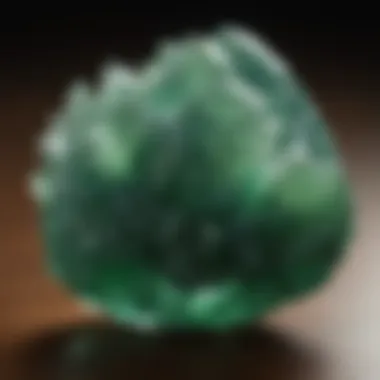
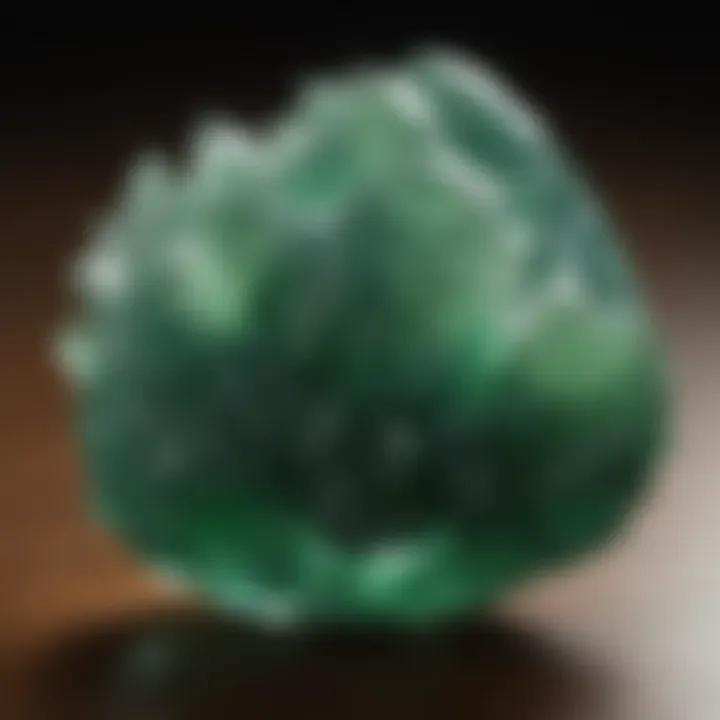
The beauty of jade lies not just in its visual appeal but also in the stories it carries through its myriad shades, from the rich greens to delicate lavenders. Designers are utilizing these striking colors to create pieces that speak directly to individual expression, making jade an appealing choice in a world that values personal style.
Design Trends Featuring Jade
In recent years, jade has made waves as a key player in several design trends. Here’s a closer look at some notable trends:
- Statement Jewelry: Bold jade pieces, such as oversized pendants and chunky bangles, are often seen as conversation starters, adding a touch of sophistication to any outfit.
- Minimalist Aesthetics: Remarkably, simple jade accessories fit perfectly within minimalist trends. The inherent elegance of jade allows for understated yet timeless designs that can complement any wardrobe.
- Mixed Materials: Jade is often combined with other materials, including metals like gold and silver. This fusion creates a striking contrast, elevating the overall impact of a piece while also appealing to various tastes.
These trends not only highlight the versatility of jade but also its potential to resonate with different consumer preferences. Designers now find jade a worthy candidate for both high-fashion and everyday wear.
Jade and Celebrity Influence
The presence of jade in contemporary fashion can be significantly attributed to its endorsement by various celebrities. From couture runways to red carpet events, the gemstone has found champions who appreciate its beauty and cultural significance. For instance, notable figures like Emma Stone and Rihanna have been spotted donning exquisite jade pieces, bringing increased visibility and desirability to the gemstone.
Celebrities often play a crucial role in shaping public perception and fashion choices. When they incorporate jade into their outfits, it sends a powerful message. Many now see jade as not just a trend but as a staple in modern jewelry boxes.
In the realm of social media, platforms like Instagram and Pinterest have become vital avenues for jade enthusiasts. Individuals share their unique jade collections, showcasing how the gemstone can be styled effortlessly in modern attire. This user-generated content significantly bolsters jade’s reputation and assures its place in the ever-evolving fashion narrative.
"Jade does more than adorn; it embodies a legacy, reflecting both rich history and current trends in fashion."
Ultimately, jade in contemporary fashion is more than just an aesthetic choice. It is a statement of values—individuality, responsibility, and a deep appreciation for timeless beauty. As the market continues to evolve, one can expect jade to remain a prominent figure in the world of fashion.
Challenges Facing the Jade Market
The jade market, despite its longstanding allure and significance, faces a myriad of challenges that could influence its future. Understanding these challenges is crucial not just for the stakeholders directly involved in the market, but also for gemstone enthusiasts, collectors, and even casual admirers. As demand for jade continues, it mirrors the complexities of global commerce, environmental issues, and the intricate web of authenticity.
Environmental Impact of Jade Mining
Jade mining, especially in regions with rich deposits like Myanmar and Guatemala, brings a double-edged sword. On one side, it provides economic opportunities; on the flip side, it can take a heavy toll on the environment. The processes involved in extracting jade can lead to significant land degradation, deforestation, and the disruption of local ecosystems.
The impact on biodiversity can be staggering. Increasingly, the operations create massive waste, displacing both flora and fauna. For instance, in Myanmar, illegal mining has devastated landscapes, which not only harms wildlife but deprives local communities of their natural resources. If steps aren’t taken to ensure sustainable practices, we risk losing more than just the jade; we may lose entire ecosystems that are vital to the planet’s health.
"Mining jade presents a chance for economic prosperity, but at what environmental cost? We must question our priorities as stewards of the earth."
Promoting sustainable mining practices, such as reducing waste and rehabilitating mined areas, could serve as a path forward. However, enforcing these practices often proves to be a challenge due to the unregulated nature of certain mining operations.
Counterfeiting and Authenticity Concerns
The rise of counterfeiting in the jade market poses yet another hurdle for consumers and collectors alike. As the market value of jade increases, so does the incentive for fraud. Unethical sellers often pass off dyed materials or synthetic substitutes as genuine jade. This deceptive practice not only misleads buyers but can also tarnish the reputation of the whole market.
To navigate these murky waters, it’s essential for buyers to educate themselves. Familiarizing with the characteristics that differentiate jadeite from nephrite, for example, can significantly help in identifying authentic pieces.
Here are some tips to consider when verifying jade authenticity:
- Color Consistency: Authentic jade exhibits a rich, vibrant color that’s uniform throughout without patches.
- Feel: Genuine jade feels cool to touch and has a dense, smooth texture.
- Sound Test: Tapping jade produces a distinct, melodic sound. If it feels off, there might be a chance it's not real.
With the availability of modern technology, services like spectrometry and digital imaging are stepping in to help in identifying genuine jade. While these advancements provide solid support against counterfeiting, the responsibility ultimately lies with buyers to stay vigilant.
In summary, challenges facing the jade market revolve around environmental sustainability and the quest for authenticity. Addressing these issues is pivotal not only for the future prosperity of the jade market but also for the preservation of its cultural and economic value.
Culmination: The Enduring Appeal of Jade
Jade holds an exceptional place in the world of gemstones, capturing the fascination of collectors and enthusiasts alike. Its allure is not merely in its physical beauty, but in the rich tapestry of cultural, historical, and contemporary significance it embodies. Understanding the enduring appeal of jade offers insight into its undeniable status as a coveted gemstone across various societies.
The Future of Jade in the Gemstone Market
As we cast our eyes towards the horizon, the future of jade in the gemstone market unveils itself amidst a shifting consumer landscape. The growing awareness of ethical and sustainable practices in mining is molding buyer preferences, pushing them towards sources that respect environmental regulations. This shift opens doors to the promotion of responsibly sourced jade, which could elevate its status and value in the eyes of new generations of collectors.
Moreover, the influence of globalization cannot be ignored. With digital platforms making it easier to buy and sell jade worldwide, we are likely to see an increase in demand from emerging markets. Enthusiasts from places like India, where the appreciation for gemstones is deeply rooted, could emerge as major players. Anticipated technological advancements in jade carving may also pave the way for innovative designs, further enriching the market offerings.
- Ethical sourcing and sustainability: As the gem industry faces pressure for transparency, many consumers are willing to pay a premium for stones that come from eco-friendly practices.
- Global demand dynamics: With increasing attention from emerging economies, jade may tap into previously unexploited markets.
"The intrinsic value of jade goes far beyond its sparkling surface; it is a narrative woven through history, culture, and the environment."
Lasting Value Beyond Monetary Aspects
The significance of jade transcends its financial worth; it sits firmly in the realm of emotional and cultural values. Each piece of jade tells a story—be it a family heirloom passed down through generations or an artifact that captures an entire civilization's ethos. The sentiment attached to jade often outweighs its market price for many individuals.
Whether serving as a token of love, a symbol of protection, or a cherished memento from travels, jade holds a nostalgic and personal value that buyers often seek in gemstones. This lingering essence of jade reaffirms its standing as more than just a gemstone but as a vessel containing memories, traditions, and legacy.
In a world increasingly focused on materialism, the irreplaceable influence of jade reminds us of what truly matters. As the markets evolve and newer generations embrace both the aesthetic and symbolic aspects of jade, its intrinsic value will continue to resonate with those who cherish deeper meanings beneath the surface.
In summary, even as we navigate the complexities of the gemstone market, jade remains a timeless entity—a reminder that true value is often found beyond mere currency.







